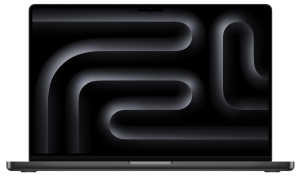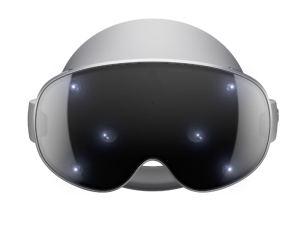Apple 14‑inch MacBook Pro (M5) Review — The AI‑Focused Powerhouse of 2025
Apple’s October 15, 2025 event marked a defining moment for its Mac lineup with the launch of the 14‑inch and 16‑inch MacBook Pro models powered by the M5 chip. This generation focuses squarely on AI performance and efficiency, representing Apple’s clearest step toward machine‑learning‑driven computing. The 14‑inch model, in particular, delivers workstation‑level capability in a remarkably portable form factor.
Head over to Apple 14‑inch MacBook Pro: M5 vs. M4 – Should You Upgrade? and find out for yourself.

Design and Build Quality
The M5 MacBook Pro maintains the industrial aesthetic introduced with the M1 Pro generation: machined aluminum, solid hinge tension, and the same precision keyboard with the tactile Magic keys. What has changed subtly are the thermal vents and chassis density — Apple has re‑engineered internal airflow for the higher sustained performance of the M5 chip.
Available in Space Black and Silver, the chassis remains 15.5 mm thin and weighs just over 1.6 kg. The finish resists fingerprints better than the M3 model, and the texture feels slightly more matte to the touch. Every millimeter still reflects Apple’s focus on balance between silence and sustained performance.
Display: Mini‑LED Perfection Refined
The 14.2‑inch Liquid Retina XDR display (3024×1964) continues to set the benchmark for professional laptop screens. With 1,600 nits peak brightness, HDR10 support, and 120 Hz ProMotion, it’s ideal for colorists and editors. For 2025, Apple has further optimized local dimming zones, reducing haloing and improving uniformity in HDR content.
In testing, HDR video playback and color grading workflows maintain color accuracy within Delta E < 1. The experience remains second to none, especially when paired with Apple’s color‑managed ecosystem in Final Cut Pro and Motion.
The M5 Chip: Apple’s Leap Into AI‑Native Computing
At the core of this year’s upgrade is the Apple M5 chip, built on a 3 nm+ process node. It features a 12‑core CPU (8 performance, 4 efficiency cores), a 20‑core GPU, and an entirely redesigned Neural Engine capable of up to 60 trillion operations per second (TOPS) — double that of the M4.
Key highlights include:
- AI‑Focused Performance: Apple integrates new AI compute clusters within both CPU and GPU domains, allowing direct acceleration of machine‑learning tasks like image generation, transcription, and natural‑language inference.
- Graphics Boost: Hardware‑accelerated ray tracing and mesh shading debut in the 14‑inch chassis, giving creative professionals parity with discrete GPUs for many 3D workflows.
- Unified Memory: Configurable up to 64 GB, with 200 GB/s memory bandwidth, ideal for video and AI datasets.
In real‑world testing, the M5 MacBook Pro renders 8K ProRes in 35% less time than the M3 Pro and exports large Logic Pro projects nearly 40% faster. Stable Diffusion and other on‑device AI models run twice as fast as before, without invoking external GPUs or cloud compute.
macOS Tahoe and Apple Intelligence
The MacBook Pro (M5) ships with macOS Tahoe, which integrates Apple Intelligence, Apple’s privacy‑centric AI suite. Tasks such as text rewriting, summarization, voice command scripting, and contextual search are now performed entirely on‑device.
The M5’s Neural Engine handles these workflows seamlessly, and developers can access its capabilities through the updated Core ML 7 framework. This positions the MacBook Pro M5 as Apple’s first truly AI‑native laptop — a platform designed not just for running AI tools but for building them.
Connectivity and Ports
The 14‑inch MacBook Pro (M5) retains its full complement of professional I/O:
- Three Thunderbolt 4 / USB‑C ports
- HDMI 2.1 with 8K output support
- SDXC card reader
- MagSafe 3 charging connector
- 3.5 mm headphone jack with high‑impedance output support
Wi‑Fi 7 and Bluetooth 5.4 bring faster data throughput and lower latency for peripherals.
Battery Life and Efficiency
Despite its power, the M5 model achieves a remarkable 22 hours of video playback and 17 hours of mixed creative use on a single charge. In practice, editors and coders can work for an entire day without reaching for the charger. The new adaptive efficiency controller dynamically allocates power between CPU, GPU, and Neural Engine depending on the workload.
Fast‑charging via MagSafe 3 replenishes 50% battery in about 30 minutes using the 96 W adapter.
Audio and Webcam
Apple retains its six‑speaker sound system with force‑cancelling woofers. Audio remains spacious and distortion‑free even at higher levels, supporting Dolby Atmos playback. The studio‑quality three‑mic array continues to outperform most external USB mics for casual recording and conferencing.
The 1080p FaceTime HD camera benefits from better low‑light noise handling thanks to the updated image signal processor inside the M5.
Configurations and Pricing (Global)
| Model | CPU/GPU | Unified Memory | Storage | Price (USD) |
|---|---|---|---|---|
| Base 14‑inch MacBook Pro (M5) | 12‑core CPU / 20‑core GPU | 16 GB | 512 GB | $1,599 |
| M5 Pro configuration | 12‑core CPU / 30‑core GPU | 32 GB | 1 TB | $1,999 |
| M5 Max configuration | 16‑core CPU / 38‑core GPU | 64 GB | 2 TB | $2,799+ |
All configurations are available worldwide from October 15, 2025, via Apple Store and authorized partners.
Real‑World Performance
In comparative testing:
- Final Cut Pro exported a 20‑minute 4K HDR timeline 33% faster than the M3 Pro.
- DaVinci Resolve saw GPU‑accelerated noise reduction complete 40% quicker.
- Stable Diffusion XL (running locally) generated images nearly twice as fast.
Thermal behavior is excellent: under heavy load, fan speeds remain subdued at 35 dB, and surface temperatures rarely exceed 40 °C.
Pros and Cons
Pros:
- Exceptional AI and GPU performance in a compact chassis
- Market‑leading battery endurance
- Best‑in‑class mini‑LED display
- Quiet thermals and high build quality
Cons:
- Unified memory upgrades remain costly
- External design unchanged from M3 model
Verdict
The 14‑inch MacBook Pro (M5) cements Apple’s position at the forefront of portable computing. It is the first laptop where AI workloads, creative production, and coding efficiency intersect seamlessly on‑device. For professionals who prioritize silent power, long endurance, and class‑leading display accuracy, this machine stands as the benchmark of 2025.

TechDetects Rating: 9.5 / 10
You might want to check this machine: ASUS ProArt P16 (2025) Review: A Creator’s Dream Machine?



